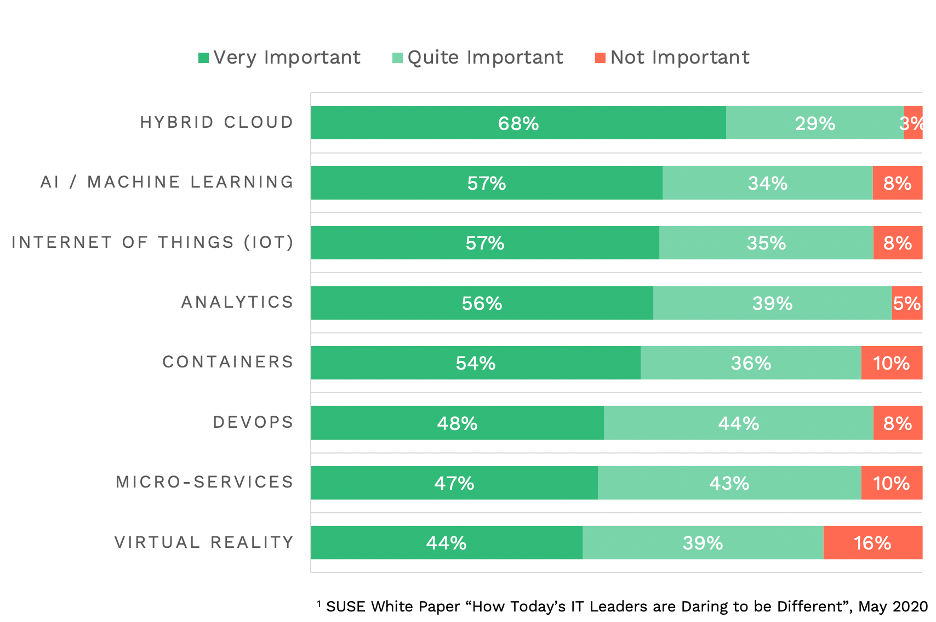Adapting for Hybrid Cloud – Part 1 of 3: The Market
In order to stay relevant and competitive in today’s rapidly changing business environment, companies need to be able to adapt quickly. And the best way to adapt is to port an infrastructure across multiple environments that is easily managed and consistent with what people are used to handling. This blog series provides some insights and guidance in how to take advantage of cloud solutions – and transform your operations while understanding the trade-offs and when to apply different options.
 These past few months have been a wake-up call like businesses have never seen before. As we all began to lay down plans for 2020, a pandemic would disrupt plans throwing a monkey wrench into investment strategies and business models. Those that could react and adapt most quickly are surviving, some even thriving, while those that couldn’t respond are falling behind – or disappearing all together. Pandemic aside, the business environment changes faster than ever in ways that can’t be entirely anticipated. Customer expectations have been totally flipped from just 10 to 15 years ago. Business must have a relationship with the customer. Combine that with the rate of change in technology, your competition is moving faster on all sides of you. Let’s discuss the trends fueling this pace of change – clouds and cloud-native computing. I specifically want to touch on considerations and factors in planning the move to the cloud — and give you some food for thought.
These past few months have been a wake-up call like businesses have never seen before. As we all began to lay down plans for 2020, a pandemic would disrupt plans throwing a monkey wrench into investment strategies and business models. Those that could react and adapt most quickly are surviving, some even thriving, while those that couldn’t respond are falling behind – or disappearing all together. Pandemic aside, the business environment changes faster than ever in ways that can’t be entirely anticipated. Customer expectations have been totally flipped from just 10 to 15 years ago. Business must have a relationship with the customer. Combine that with the rate of change in technology, your competition is moving faster on all sides of you. Let’s discuss the trends fueling this pace of change – clouds and cloud-native computing. I specifically want to touch on considerations and factors in planning the move to the cloud — and give you some food for thought.
Importance of enhancing skills and experience in key areas
 This diagram is from a survey we did a few months ago showing the importance of key areas in the business transformation journeys. We are seeing momentum gaining in high performance computing, edge computing, AI and machine learning and hybrid cloud. The chart shows how important the responders think these areas are to their businesses. At the top of the list you see hybrid cloud – a mixed computing environment that combines on-premise infrastructure with private cloud services and public cloud – that has coordination across those platforms. That’s the most encompassing category in the whole list.
This diagram is from a survey we did a few months ago showing the importance of key areas in the business transformation journeys. We are seeing momentum gaining in high performance computing, edge computing, AI and machine learning and hybrid cloud. The chart shows how important the responders think these areas are to their businesses. At the top of the list you see hybrid cloud – a mixed computing environment that combines on-premise infrastructure with private cloud services and public cloud – that has coordination across those platforms. That’s the most encompassing category in the whole list.
Cloud as a key accelerator
When you hear the word “cloud” today, what comes to mind? Is it a vast data center far away that someone else is responsible for? Is it Amazon, Microsoft Azure, or Google? Think about cloud as an operational model, not as a place. A model inclusive of operational aspects, shared services, and even the paradigm in application architecture and delivery, represented in Cloud-Native applications and continuous integration and continuous delivery. When you do that, and apply the continual evolution of technology, the cloud model is ever expanding to enable IT organizations to delivery similar services and cost efficiencies from corporate owned or co-located data centers. And most recently, encompassing Edge computing and IoT.
Public cloud isn’t for everything when you consider data control and storage costs or an edge computing environment. And it’s more than just infrastructure, including services and an application delivery and operations model. The result will likely be a hybrid cloud or multi-cloud environment. And statistics show that the vast majority of enterprises have a multi-cloud or a hybrid cloud strategy. There are various factors which impact the use and adoption of public cloud – both positively and negatively. Apprehension around security and compliance could significantly challenge public cloud adoption, while return on investment and interoperability could significantly drive adoption.
Most enterprises today are pursuing a hybrid strategy, mixing and matching public and on-prem venues depending on each workload’s requirements. One of the issues facing enterprises with hybrid today is the difference in pricing and procurement models. For public cloud, on-demand operating expense pricing is pretty mainstream, and this on-demand access to huge capacity is one of the key drivers behind public cloud adoption, driving more rapid instantiation of resources, allowing the scaling of applications to suit changing demands, making innovation easier and simplifying entry into new markets.
Cloud-optimized enterprises lead ultimately to better customer experiences
To be successful with a hybrid cloud strategy, things around control, data management, governance and data usage need to be worked out. Cloud cannot be just one team’s responsibility. You’ll need to align corporate and leadership objectives that Cloud projects can directly impact. You’ll need to align IT deliverables to applications, services and initiatives that are critical to specific business goals. And you’ll need to assess the cloud value proposition by using language and metrics that present the value story from the business perspective.
This journey leads to decisions around your investment strategies, the skills you have and need to invest in, your business and application profile, and your customers’ requirements. The cloud will not automatically lead to cost savings, or eliminate IT management, but revenue can be increased with cloud’s extra reach and on-demand scalability. Cost efficiency can be achieved with optimization of resources. And risks can be mitigated with less operational downtime. Having a strategy for a cloud-optimized enterprise helps you realize these benefits.
What are the common elements found in companies successfully making the transformation to winning with the cloud?
- Think Holistic: It starts with an enterprise cloud strategy bought into at all levels of the company. If everyone isn’t fully bought in, and on the same page, a company is destined for serious challenges. A cloud strategy isn’t the responsibility of the IT department, or the operations team, the C-Suite, or any other individual organization. Each organization from business units to IT to finance will play a role in define, implementing, executing and measuring the transformation to a cloud-optimized enterprise.
- Think Focused, Business-Aligned Efforts: when executing on the elements of the cloud strategy, implement focused, business aligned projects that have a finite scope but are in support of the long-term strategy. Identify what the business driver is of each project and execute to impact one or more of 3 bottom-line metrics: Revenue Impact, Cost Efficiency, or Risk Mitigation.
- Think open source and portable solutions. This is evident in almost every aspect of cloud growth, from the fast-evolving containerized infrastructure to cloud-native application development models. As you are defining your implementation strategy, you want to maintain an openness to your solution to enable you to take advantage of the community innovation. Open source solutions today enable you to build your application in one environment, initially deploy it in another and scale it as demand grows. In a multi-/hybrid- cloud world, your application should not be locked into a silo, but be able to be moved as business needs demand.
Customer needs and concerns have changed. They want to avoid vendor lock-in – not just around Linux OS but everything. They are already using the cloud but want flexibility to move or extend across different providers if and when needs change and with geographic shifting of new customer bases. They are starting to develop cloud-native applications, struggling to manage complex Kubernetes environments and dealing with interoperability issues.
Checklist and considerations for workload migration to the Cloud
As demand changes and your datacenter configuration evolves, the cloud provides the flexibility you’ll need to adapt and optimize. Finding the optimal environment for your workloads requires you to consider several factors:
- Storage: Data movement can be a major bottleneck for operations. Minimizing data movement often means that, if the data is stored in the cloud, the workload should run in the cloud. And if the data resides on the local network, your best option is to provide your primary resources locally and use the cloud for bursting in times of peak load. Financial risk assessments that consume a lot of market data are I/O intensive and could require ultra-low latency. I/O-bound workloads like these might not be as amenable to cloud environments.
- Network: Network-bound workloads require a lot of bandwidth. Bursting is less efficient with slower internet connections and works better for compute-intensive workloads that minimize network traffic. If extensive node-to-node communication is required, as in deep learning applications, going “all-in” to the cloud might not be ideal.
- Compute: If node-to-node communications and data movement are less of an issue, and the applications are more compute intensive, there could be a strong case for running those workloads in the cloud. Compute-intensive applications such as genome sequencing could benefit from an extreme-scale environment provided by the cloud.
- Throughput: Certain workloads can benefit from an extreme-scale environment that clouds can provide. If there is data parallelism, meaning that there is shared data across concurrently running jobs, without a need for communications between the jobs, a scalable environment such as the cloud could be ideal.
- Cost: Building and maintaining a local hardware infrastructure requires overhead, which becomes part of the total cost of using the system, but the contribution of these start-up costs to the average per-cycle expense diminishes as usage increases. On the other hand, the all-cloud option might have a higher per-cycle operational cost that is relatively constant with increased usage. A local cluster with bursting is, therefore, more efficient for systems that are heavily utilized. In addition, all-cloud is a better option for organizations that expect lighter usage.
Organizations are simplifying their operations and technology infrastructure, processes, and resources in order and optimize cost and gain more efficiency. Data loss, data breaches, cyberattacks and compliance violations are costly as well as damaging to brands; and increasingly more difficult for companies to avoid. Organizational security and compliance are critical components of many IT initiatives. In order to innovate and stay competitive, organizations must modernize their infrastructure to support the growing need to uncover strategic insight and deep learning from their complex datasets across multiple platforms. Companies must be prepared for disruption and ensure continued, reliable operations, while also building on the ability to quickly adapt and change with unplanned market, customer, service or other disruptive events.
Thanks for reading!
Learn more about SUSE for hybrid cloud:
- https://www.suse.com/solutions/cloud/
- https://www.suse.com/products/cloud-application-platform/
- https://www.suse.com/programs/cloud/public/
Related Articles
Oct 07th, 2022
Join SUSE at SAPinsider EMEA Nov 15-17 in Vienna
Sep 23rd, 2022
No comments yet